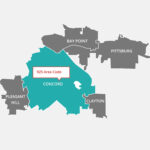Area codes are integral to our phone communication system, acting as the first three digits of a telephone number. They were introduced in the late 1940s to manage the burgeoning demand for telephone services after World War II. Currently, there are 792 area codes in use. Following the area code is the prefix, the next three digits, which can start with any number except 0 or 1 and cannot end in 11. The final four digits offer 10,000 possible combinations, from 0000 to 9999. For a visual representation of area codes across the nation, a map is available at https://nationalnanpa.com/area_code_maps/ac_map_static.html.
The responsibility for overseeing and assigning area codes falls to the North American Numbering Plan Administrator (NANPA). This organization monitors telephone number usage and introduces new area codes as needed.
Delving into Area Code 480 in Arizona
Area code 480 is located in Arizona, specifically serving the southcentral region of the state. This encompasses a significant portion of the Phoenix metropolitan area, including cities like Chandler, Gilbert, Mesa, Tempe, Scottsdale, and Sun Lakes, primarily within Maricopa and Pinal counties. Originally, this region was part of area code 602. However, in 1999, to accommodate growth, the Phoenix rate center was divided, creating area codes 480 and 623 alongside the existing 602.
Area code 602 is adjacent to 480 on the west, covering most of Phoenix, parts of Glendale, and communities such as Cave Creek and Ahwatukee. Area code 623 borders 602 to the west and north, and 480 to the west, serving areas including Glendale, Avondale, Tolleson, Buckeye, Sun City, and New River. A rate center, for clarification, is a geographical zone defining local calling boundaries, billing, and phone number assignments, potentially spanning multiple area codes.
The Boundary Elimination Overlay for 480, 602, and 623
Due to increasing demand for phone numbers, area code 480 is projected to exhaust its supply of central office codes by early 2024. In response to this impending scarcity, and following NANPA guidelines, an Arizona telecommunications Industry meeting was held on April 28, 2021, to discuss relief strategies. The consensus reached was to recommend a Boundary Elimination Overlay to the Arizona Corporation Commission (Commission).
NANPA formally applied to the Commission on June 8, 2021, on behalf of the Industry, advocating for the Boundary Elimination Overlay as the solution for the 480 area code’s resource depletion. The Commission approved this plan on November 2, 2021, via Decision No. 78311.
A Boundary Elimination Overlay merges area codes by removing geographical boundaries between them. In this instance, the boundaries between 480, 602, and 623 are eliminated, creating an overlay where all three area codes serve the same geographic region. This change necessitates 10-digit dialing for all calls within and between these area codes.
Advantages of the Boundary Elimination Overlay
This approach offers several benefits:
- Avoids New Area Codes: It negates the need to introduce a new area code specifically for the 480 region.
- Future-Proofs Numbering: Given that area code 602 is also projected to exhaust by the second quarter of 2026, this overlay preemptively addresses the need for further relief planning and additional new area codes for the 602 region as well.
- Preserves Existing Numbers: Existing customers are not required to change their current area code or phone number.
- Simplifies the Phoenix Rate Center: It reunifies the Phoenix rate center, undoing the 1999 split and simplifying local calling.
- Statewide 10-Digit Dialing Consistency: This overlay, combined with the Federal Communications Commission’s (FCC) mandate for 10-digit dialing for the 988 National Suicide Hotline across area codes 480, 520, and 928, establishes a uniform 10-digit dialing system throughout Arizona.
- Efficient Resource Utilization: It represents a more efficient allocation of numbering resources.
Challenges of the Boundary Elimination Overlay
However, there are also challenges:
- Inconvenience of 10-Digit Dialing: Customers in the 602 and 623 area codes are now required to dial 10 digits, sooner than they might have otherwise needed to based on previous projections. Without the overlay, 602 might not have required relief for another five years and 623 for as much as 48 years.
- Loss of Geographic Association: The overlay diminishes the ability to associate a specific area code with a distinct geographic location.
Understanding 10-Digit Dialing
10-digit dialing simply means including the area code for all local calls. Instead of dialing just the 7-digit number, you must now dial the full 10-digit number, area code included, for every call – even local ones.
Who is Affected?
While customers in the 480 area code were already accustomed to 10-digit dialing, this change primarily affects customers in the 602 and 623 area codes. It does not impact customers in other Arizona area codes. This transition ensures the continued availability of phone numbers and streamlines the dialing process across the Phoenix metropolitan area and throughout Arizona.

